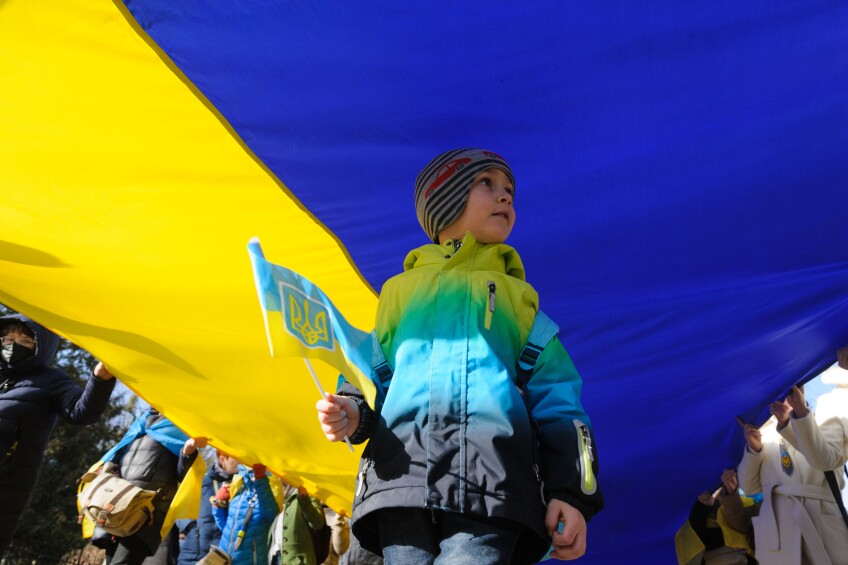How to Talk to Kids About the Ukraine Invasion

I want to talk to parents and caregivers of preschool and elementary-age kids for a moment. The news right now out of Europe is scary. Sometimes, our instinct is to avoid talking to kids about tough stuff on the news because we don’t want to upset them. And perhaps we don’t know where to start.
My kids are on school vacation this week, but when they return, their classmates will be talking about Russia and Ukraine. So, if my kids haven’t had conversations with me about it first, they’ll get their initial information from someone else.
I’m not advocating sticking young kids in front of cable news. But there’s an insight from Fred Rogers that touches all aspects of my parenting:
Anything that’s human is mentionable, and anything that is mentionable can be more manageable. When we can talk about our feelings, they become less overwhelming, less upsetting and less scary.
Our job is to provide our kids with accurate, age-appropriate information, while reminding them that they are safe and they are loved.
So how do we do that?
Yesterday, my 8-year-old and I spent a chunk of time talking about the invasion of Ukraine. He understood more — contextually and empathetically — than I expected.
Here are a few things that helped:
1. A map: I pulled out the globe and asked him to put his finger on Ukraine, Russia and the Black Sea. We touched other countries and talked a bit about the formation and breakup of the Soviet Union (just simple history/geography).
2. We talked about some of the reasons wars start and how this was a "war of choice," because Russia's leader wants "more." This is simply wrong, like it would be wrong for someone to break into his room and say "All of this is mine."
3. I explained sanctions in simple terms and named some of the other countries imposing sanctions. I also showed him a picture of Russians protesting because I don't want him to conflate the actions of a tyrant with an entire country of people.
4. We talked about refugees. I reminded him about the donation drive we did to collect items for Afghan refugees last fall. I showed him a picture of Ukrainians in a train station, trying to leave. "Let's be on the lookout for ways to help," I told him.
5. It was helpful that we've talked a lot about refugees in age-appropriate ways for years. He knows his grandfather fled Austria when Germany invaded. That's part of his family history. We connected those dots.
Finally, I told him that we'd keep talking about it and that he can ask me questions anytime.
But, What If Your Children Are Even Younger?
For children in pre-K and kindergarten, it’s still worth having these conversations because when we don’t, their imagination will often fill in the details based on snippets they pick up from classmates or adult conversations. But you can make the details even simpler.
1. Try using a metaphor like the one above: You can ask your child, "How would you feel if someone took all your toys without asking? Right now, the leader in one country, Russia, is trying to take another country and say 'Ukraine is mine.' That’s not right and that’s why lots of other countries, including the United States, are telling him to stop." Pull out a map and show them where they live and where this is happening. Then, see what questions they have and answer them in simple terms.
2. Reassure them that they are safe and loved. That’s a huge part of our job. Remind them that they can always bring you their questions and worries.
3. Point out what people are trying to do to help. Remind them that some people are helping refugees or donating money to help them, some people in Russia are protesting and telling their president to stop, etc. As Fred Rogers’ mother would tell him during scary times, "Look for the helpers."
4. Books are a great way to open up younger children’s understanding of the world and foster empathy. Here are three picture books about refugees that can help kids get a better understanding of this and other conflicts around the world.
- "What Is a Refugee?" (Ages 3-7) by Elise Gravel
This book is a simple, accessible introduction to what it means to be a refugee.
- "Lubna and Pebble" (Ages 4-8) written by Wendy Meddour and illustrated by Daniel Egnéus
A young girl holds on to her special pebble at a refugee camp — only to give it to a child who needs it even more.
- "Lost and Found Cat: The True Story of Kunkush's Incredible Journey" (Ages 4-8) written by Doug Kuntz and Amy Shrodes; illustrated by Sue Cornelison
The true story of how aid workers in Greece helped an Iraqi refugee family reunite with their beloved pet.
As caregivers, we need to be mindful of the coverage our kids see and hear on TV and on the radio, as well as what they listen to over phone calls with friends and family. Images can be scary and overwhelming. But I believe in starting to mindfully build kids' knowledge of the world at a young age, and doing it in a way that fosters their empathy and compassion.


